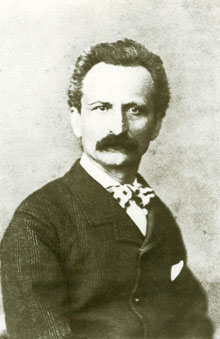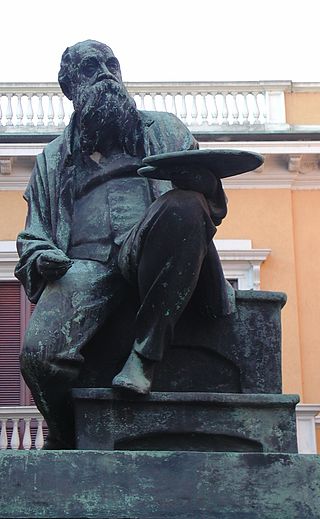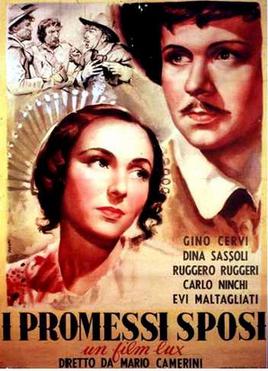Related Research Articles

The Betrothed is an Italian historical novel by Alessandro Manzoni, first published in 1827, in three volumes, and significantly revised and rewritten until the definitive version published between 1840 and 1842. It has been called the most famous and widely read novel in the Italian language.

Pisanello, born Antonio di Puccio Pisano or Antonio di Puccio da Cereto, also erroneously called Vittore Pisano by Giorgio Vasari, was one of the most distinguished painters of the early Italian Renaissance and Quattrocento. He was acclaimed by poets such as Guarino da Verona and praised by humanists of his time, who compared him to such illustrious names as Cimabue, Phidias and Praxiteles.

Francesco "Nino" Castelnuovo was an Italian actor of film, stage and television, best known for his starring role as Guy Foucher in the French musical film The Umbrellas of Cherbourg (1964).

Giovanni Fattori was an Italian artist, one of the leaders of the group known as the Macchiaioli. He was initially a painter of historical themes and military subjects. In his middle years, inspired by the Barbizon school, he became one of the leading Italian plein-airists, painting landscapes, rural scenes, and scenes of military life. After 1884, he devoted much energy to etching.
Justus Sustermans, Joost Sustermans or Suttermans, his given name Italianised to Giusto, was a Flemish painter and draughtsman who is mainly known for his portraits. He also painted history and genre paintings, still lifes and animals.

Ridolfo di Domenico Bigordi, better known as Ridolfo Ghirlandaio was an Italian Renaissance painter active mainly in Florence. He was the son of Domenico Ghirlandaio.

Alessandro Tiarini was an Italian Baroque painter of the Bolognese School.

Silvestro Lega was an Italian realist painter. He was one of the leading artists of the Macchiaioli and was also involved with the Mazzini movement.

Alessandro Magnasco, also known as il Lissandrino, was an Italian late-Baroque painter active mostly in Milan and Genoa. He is best known for stylized, fantastic, often phantasmagoric genre or landscape scenes. Magnasco's distinctive style is characterized by fragmented forms rendered with swift brushstrokes and darting flashes of light.

Bernardino Poccetti, also known as Barbatelli, was an Italian Mannerist painter and printmaker of etchings.

Giovanni Antonio Sogliani was an Italian painter of the Renaissance, active mainly in Florence.

Cornelis de Wael was a Flemish painter, engraver and merchant who was primarily active in Genoa in Italy. He is known for his genre paintings, battle scenes, history paintings and still lifes. Through his art work, support for Flemish painters working in Italy and role as an art dealer, he played an important role in the artistic exchange between Italy and Flanders in the first half of the 17th century. His work also had an influence on local painters such as Alessandro Magnasco, particularly through his scenes of despair and irony.

Antonietta Brandeis (1848–1926), was a Czech-born Italian landscape, genre and portrait painter, as well as a painter of religious subjects for altarpieces.

Mosè Bianchi (1840–1904) was an Italian painter and printmaker.

Enrico Bartezago was an Italian painter, active in Milan, painting genre scenes, Portraits, and watercolors. In the exhibition of Paris of 1878, he displayed L' aia d' una fattoria lombarda. At the Mostra di Venezia of 1887, he exhibited La scimmia. Other works include Mercato a Varallo and Nemici. In 1891–92, he won the Mylius prize from the Academy at Milan for genre painting for his Alpine Pennine.

Teofilo Patini was an Italian painter, active in a Realist style.

Niccola Cianfanelli was an Italian painter and restorer. He mainly painted historic and sacred subjects in a Neoclassical style.

Raffaello Sorbi was a 19th-20th century Florentine painter, specializing in narrative painting.

Pompeo Massani was an Italian painter who mainly depicted costume genre subjects, often in satirical poses.

The Betrothed is a 1941 Italian historical drama film directed by Mario Camerini and starring Gino Cervi, Dina Sassoli and Ruggero Ruggeri. It is an adaptation of the 1827 novel The Betrothed by Alessandro Manzoni. The film's producers organised a competition to select the lead actress which was modelled on the hunt for Scarlett O'Hara by the American producer David O. Selznick for Gone With the Wind. It belongs to the movies of the calligrafismo style.
References
- ↑ Catalogo Bolaffi della pittura italiana dell'800; (1964) Issue 1; Page 454.
- ↑ Biography.
- ↑ Dizionario degli Artisti Italiani Viventi: pittori, scultori, e Architetti., by Angelo de Gubernatis. Tipe dei Successori Le Monnier, 1889, page 537.